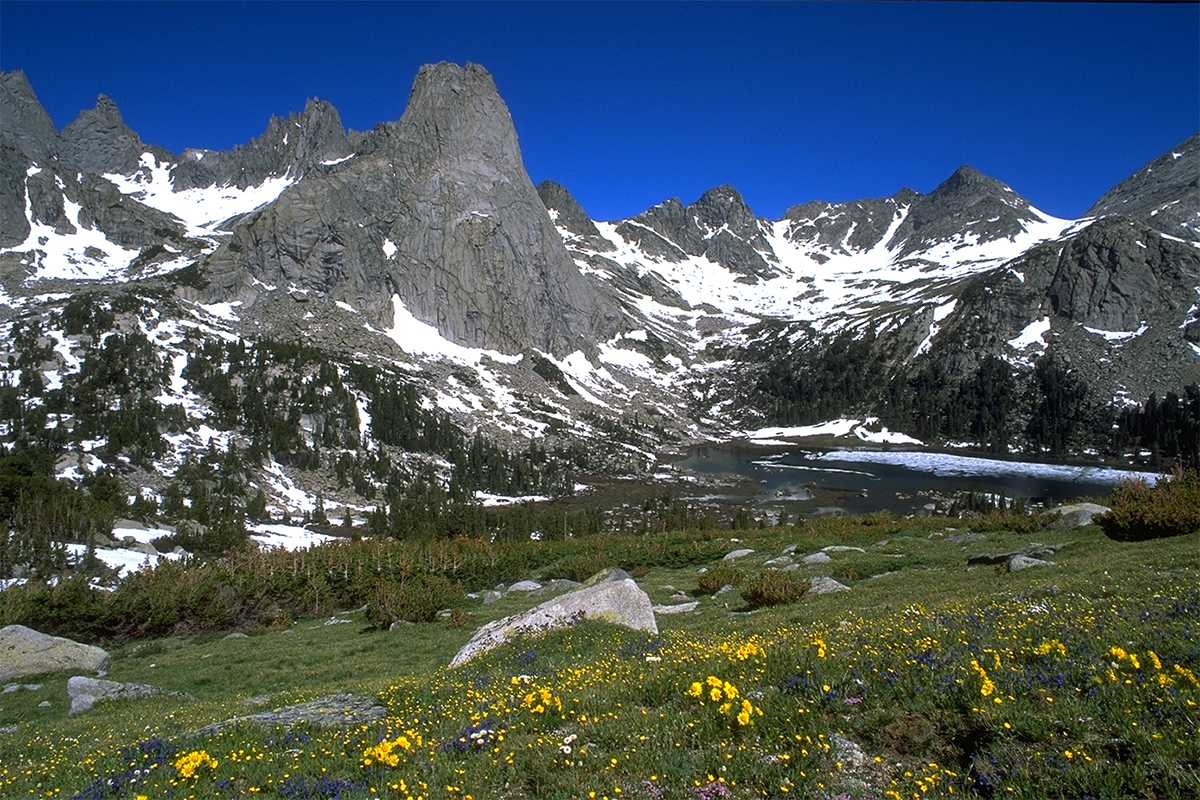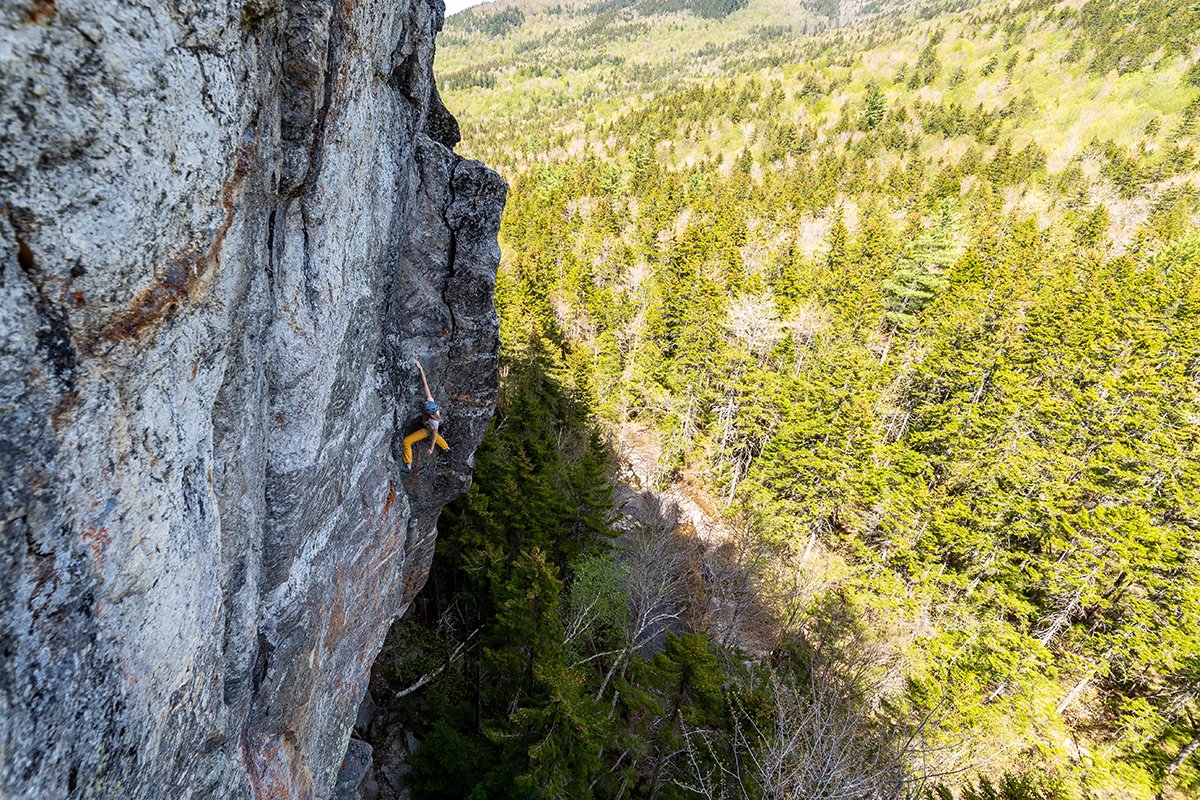America’s vast Wilderness offers climbers a chance to connect with nature, find solitude among incredible landscapes, and put our self-reliance to the test in the backcountry. Generations of climbers have sought the wild and adventurous climbing found in these unique landscapes, which are home to some of the greatest natural wonders and thriving ecosystems in the country.
The Wilderness Act of 1964 gave Congress the ability to protect America’s Wilderness and prevent development from taking place there. Designated Wilderness areas receive the highest level of protection available for public lands in order to preserve these backcountry landscapes.
These eight climbing destinations exemplify Wilderness climbing and the importance of protecting and conserving the land.
1. White Mountains, New Hampshire
White Mountains, New Hampshire. Ancestral lands of Wabanaki, N’dakina, and Pequawket. © Josh Laskin
What was once razed and blackened in the name of industry now stands as a proud hardwood forest surrounding the granite peaks, notches, and talus fields of the White Mountains. The area was protected and rehabilitated thanks to the creation of White Mountains National Forest and four separate Wilderness zones within its bounds. This land and its many backcountry crags—like Wild River Crag in the Wild River Wilderness, pictured above—offer remote climbing experiences that are protected against the development and damaging extraction that threatens so many other crags across America.
2. The Big Walls of Yosemite, California
Yosemite National Park, California. Ancestral lands of Me-Wuk, Nüümü, and Miwok. © Francois Lebeau.
Yosemite is part of a vast tract of Wilderness that protects a wide swath of the Sierra Nevada mountain range. Yosemite Wilderness alone protects over 700,000 acres of wild lands, including iconic formations like El Capitan, Half Dome, and Washington Column. Climbers aren’t the only ones who appreciate these vertical landscapes—peregrine falcons raise their young on cliff ledges high above the valley floor. The Yosemite Wilderness boundary starts just a few hundred feet from the road in most places on the Valley Floor, protecting the walls as crucial wildlife habitat and demanding the utmost respect from climbers who scale the granite formations.
3. Black Canyon of the Gunnison National Park, Colorado
Black Canyon of the Gunnison National Park, Colorado. Ancestral Ute lands. © Brittany Hamilton.
Frequently bold, often difficult, and always thrilling, the Black Canyon is internationally known as one of America’s most adventurous and wild climbing destinations—the very definition of long, traditional, backcountry Wilderness climbing. The Black Canyon of the Gunnison Wilderness and Gunnison Gorge Wilderness abut each other to protect the remote, self-reliant nature of the canyon’s challenging climbing—like the routes on Painted Wall, Colorado’s tallest cliff—and the unique black granite of the canyon walls.
4. Joshua Tree National Park, California
Joshua Tree National Park, California. Ancestral lands of Yuhaaviatam/Maarenga’yam and Newe Sogobia. © Damon Corso.
Three distinct landscapes converge in the Joshua Tree Wilderness—the Colorado Desert, the Mojave Desert, and the San Bernardino Mountains—which gives the area its unique mix of plant and animal life and otherworldly feel. Climbers who spend time in the area often develop a deep appreciation and respect for the unique landscapes, the cultural resources, and the stout climbing to be found on the boulders and domes scattered about the desert flats.
5. Linville Gorge, North Carolina
Linville Gorge, North Carolina. Ancestral lands of ᏣᎳᎫᏪᏘᏱ Tsalaguwetiyi, S’atsoyaha, and Mánu Yį Įsuwą. © Shannon Millsaps.
Linville Gorge, carved by its namesake river over thousands of years, encompasses 12 miles of rugged and wild land where climbers can find adventure scaling the cliffs that rise out of the pristine hardwood forest. The walls of North Carolina’s Linville Gorge Wilderness are also home to a number of lichen species that aren’t found anywhere else in the world, including a number of glacial relicts—cold-adapted plant species left behind from the last ice age as the glaciers receded.
6. Red Rock Canyon National Recreation Area, Nevada
Red Rock Canyon National Recreation Area, Nevada. Ancestral lands of Nüwüwü, Nuwuvi, and Newe Sogobia. © Al Baker.
The cliffs, canyons, and boulder fields that attract so many climbers to Red Rock Canyon National Recreation Area are also home to over 100 species of native plants that can’t be found anywhere else. This unique flora, plus the area’s rich cultural resources and animal life led to the designation of three connected Wilderness areas—Mount Charleston Wilderness, Rainbow Mountain Wilderness, and La Madre Mountain Wilderness—that protect thousands of routes and hundreds of thousands of acres of land.
7. The Wind River Range, Wyoming
Wind River Mountains, Wyoming. Ancestral lands of Newe Sogobia, Cayuse, Umatilla and Walla Walla, Apsáalooke, and Tséstho’e.
The Wind River Range borders the Continental Divide and consists of millions of acres of peaks, lakes, forest, meadows, and glaciers—including the largest glacier in the Rockies. It offers incredible climbing and mountaineering adventures, and it’s also a critical landscape to preserve through Wilderness designation. A chain of Wilderness areas runs through the range, ensuring that this fragile alpine environment remains as close to its natural state as possible.
8. North Cascades, Washington
North Cascades, Washington. Ancestral lands of Nłeʔkepmx Tmíxʷ, Syilx, Sauk Suiattle, Confederated Tribes of the Colville Reservation, Cayuse, Umatilla and Walla Walla. © Jerry Dodrill.
Nicknamed the American Alps, the portion of the Cascade Range that pushes into northern Washington is an immaculate alpine environment. Climbers and mountaineers flock to the area’s rugged peaks, forested valleys, and emerald lakes to put their self-reliance to the test. In the industrial boom after World War II, industry, mining, and logging operations threatened to pave, extract, and clear cut the pristine environment into oblivion. Conservation forces took action to protect the environment and compelled Congress to create the new North Cascades National Park, its adjoining national recreation areas, and, later, an official Wilderness designation.
Ready to go deeper?
Wilderness areas are just one of the ways of protecting and conserving public lands. Learn more about how climbing and conservation go hand in hand, and the role climbers play in the greater conservation movement.








